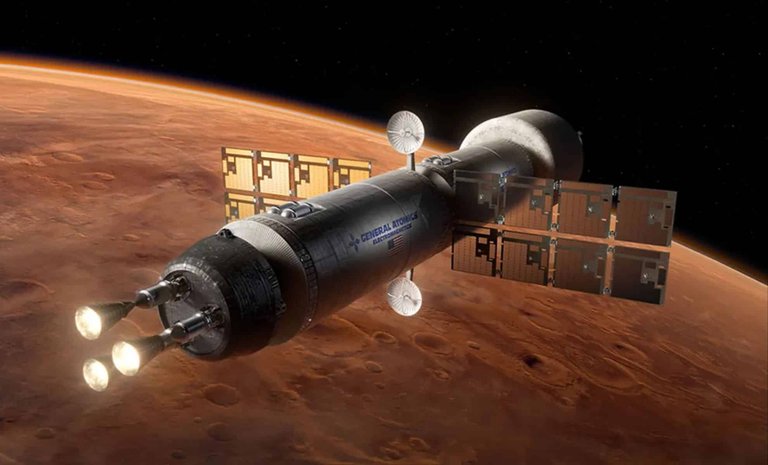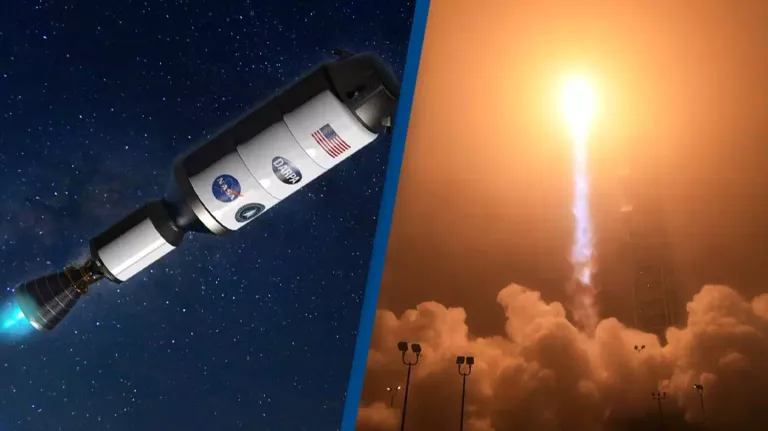Source

We have already mentioned that one of the biggest obstacles in the space race is the crazy distances that separate some celestial objects from others. The second closest planet to Earth is Mars and it is at an average distance of more than one hundred million kilometres, so with current propulsion technology it would take us about six months to reach Mars.
Ya hemos comentado que uno de los mayores escollos en la carrera espacial son las distancias delirantes que separan unos objetos celestes de otros. El segundo planeta más cercano a la Tierra es Marte y está a una distancia media de más de cien millones de kilómetros por lo que, con la tecnología de propulsión actual, tardaríamos unos seis meses en llegar a Marte.
If we talk about going to the nearest star, the distance is already measured in trillions of kilometers, which is already beyond our comprehension. That is why NASA and other space agencies invest in the research and development of nuclear propulsion engines, seeking to take advantage of nuclear energy to generate a greater amount of thrust and significantly reduce travel time.
Si hablamos de ir a la estrella mas cercana, la distancia ya se mide en billones de kilómetros, lo cual ya se escapa de nuestra comprensión. Por eso la NASA y otras agencias espaciales invierten en la investigación y desarrollo de motores de propulsión nuclear, buscando aprovechar la energía nuclear para generar una mayor cantidad de empuje y reducir significativamente el tiempo de viaje.
Source

There are different approaches, such as nuclear thermal propulsion and nuclear electric propulsion. Each has its advantages and challenges. Recently, a group of scientists have made a significant breakthrough in space propulsion by successfully testing a new fuel for nuclear thermal propulsion (NTP) systems.
Existen diferentes enfoques, como la propulsión térmica nuclear y la propulsión eléctrica nuclear. Cada uno tiene sus ventajas y desafíos. Recientemente, un grupo de científicos han logrado un avance significativo en la propulsión espacial, al probar con éxito un nuevo combustible para sistemas de propulsión nuclear térmica (NTP).
NTP systems work by pumping a liquid propellant, such as hydrogen, through a reactor where the fission of uranium atoms generates heat. This process converts the propellant into a gas, which expands through a nozzle to generate thrust. This technology offers significantly greater efficiency than traditional chemical propulsion, enabling faster and safer travel in deep space.
Los sistemas NTP funcionan bombeando un propelente líquido, como hidrógeno, a través de un reactor donde la fisión de átomos de uranio genera calor. Este proceso convierte el propelente en gas, que se expande a través de una tobera para generar empuje. Esta tecnología ofrece una eficiencia significativamente mayor que la propulsión química tradicional, lo que permite viajes más rápidos y seguros en el espacio profundo.
Source

Recent tests at NASA's Marshall Space Center have shown that the new fuel can withstand extreme temperatures, reaching up to 3,000 degrees Kelvin (about 2,730 degrees Celsius), without degrading. This success represents a crucial step toward implementing nuclear propulsion on manned missions to Mars and beyond.
Las pruebas recientes en el Centro Espacial Marshall de la NASA han demostrado que el nuevo combustible puede soportar temperaturas extremas, alcanzando hasta 3.000 grados Kelvin (aproximadamente 2.730 grados Celsius), sin degradarse. Este éxito representa un paso crucial hacia la implementación de la propulsión nuclear en misiones tripuladas a Marte y más allá.
But we must be cautious: although important progress has been made, there is still a long way to go before we can send manned missions to Mars using nuclear propulsion. However, these developments are very promising and could mark a turning point in space exploration.
Pero, hemos de ser cautos, aunque se han logrado avances importantes, aún queda mucho camino por recorrer antes de que podamos enviar misiones tripuladas a Marte utilizando propulsión nuclear. Sin embargo, estos desarrollos son muy prometedores y podrían marcar un antes y un después en la exploración espacial.
More information/Más información
https://www.newsnationnow.com/space/nasa-testing-fuel-mars/
This is really a very good and positive update if you will ask me. I am really positive about what it will bring out in few years to come actually
I have been fascinated with the photos from the latest telescopes and developments/discoveries that have been made recently. The mars rover is neat and I recently saw a picture from the surface of a moon of Venus I think it might be? Crazy stuff.
Whenever I think nuclear, I always start thinking of what could go wrong as if we were still in the 80s and hadn’t made any progress in the safety. Surely we are making strides in scaling the reactors down to feasibly functional size and handling the waste?
Wouldn’t it be awesome to follow that adventure and share in the discoveries they make?
The race has already started.
Congratulations @mauromar! You have completed the following achievement on the Hive blockchain And have been rewarded with New badge(s)
You can view your badges on your board and compare yourself to others in the Ranking
If you no longer want to receive notifications, reply to this comment with the word
STOP